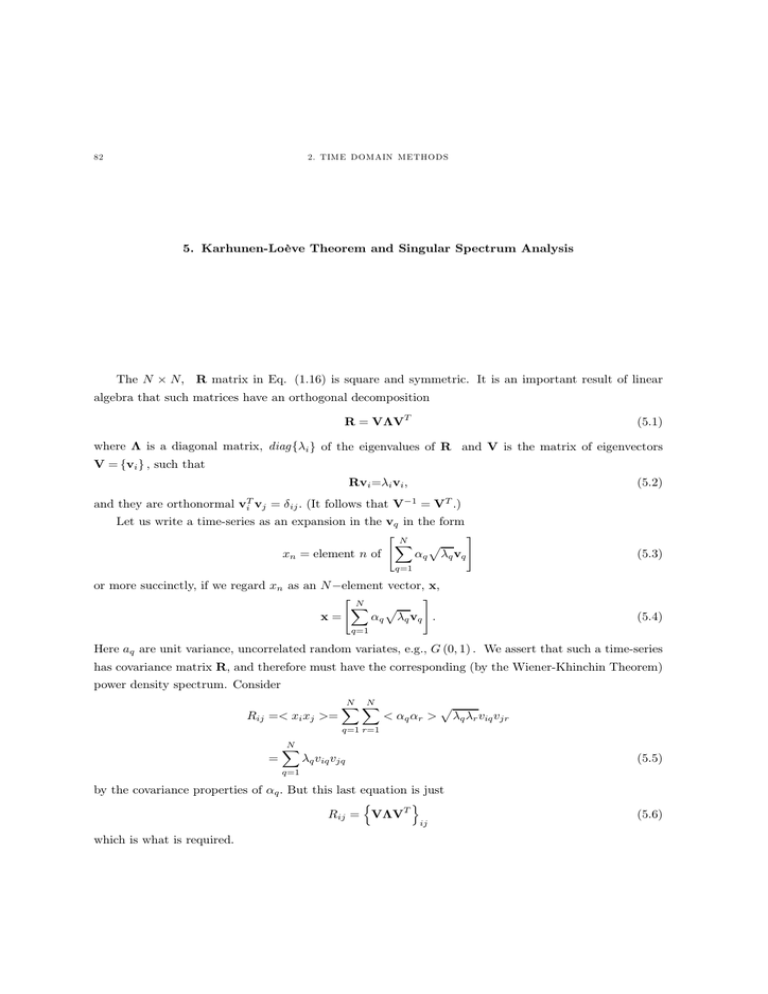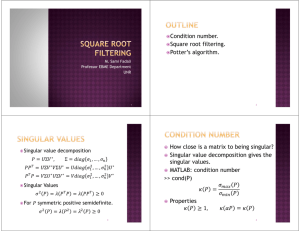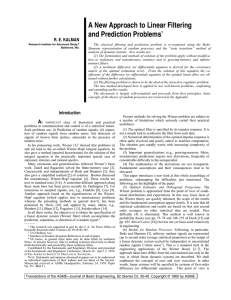5. Karhunen-Loève Theorem and Singular ... × Q> R matrix in Eq. ...
advertisement

82
2. T IM E D O M A IN M E T H O D S
5. Karhunen-Loève Theorem and Singular Spectrum Analysis
The Q × Q> R matrix in Eq. (1.16) is square and symmetric. It is an important result of linear
algebra that such matrices have an orthogonal decomposition
R = VVW
(5.1)
where is a diagonal matrix, diag {l } of the eigenvalues of R and V is the matrix of eigenvectors
V = {vl } > such that
Rvl =l vl >
and they are orthonormal
vlW vm
= lm = (It follows that V
1
(5.2)
= V =)
W
Let us write a time-series as an expansion in the vt in the form
"Q
#
X p
{q = element q of
t t vt
(5.3)
t=1
or more succinctly, if we regard {q as an Q element vector, x>
"Q
#
X p
x=
t t vt =
(5.4)
t=1
Here dt are unit variance, uncorrelated random variates, e.g., J (0> 1) = We assert that such a time-series
has covariance matrix R> and therefore must have the corresponding (by the Wiener-Khinchin Theorem)
power density spectrum. Consider
Ulm =? {l {m A=
Q X
Q
X
? t u A
p
t u ylt ymu
t=1 u=1
=
Q
X
t ylt ymt
(5.5)
t=1
by the covariance properties of t = But this last equation is just
n
o
Ulm = VVW
lm
which is what is required.
(5.6)
83
Exercise, Confirm (5.6).
Thus (5.4) gives us another way of synthesizing a time series from its known covariance. That the
decomposition (5.4) can always be constructed (in continuous time) for a stationary time series is called
the Karhunen-Loève Theorem (see Davenport and Root, 1958). Because it is based upon a decomposition
of the covariance matrix, it is evidently a form of empirical orthogonal function synthesis, or if one prefers,
an expansion in principal components (see e. g., Jollie, 1986).
The relative importance of any orthogonal structure, vl > to the structure of {q > is controlled by the
s
magnitude of l = Suppose one has been successful in obtaining a physical interpretation of one or more of
the important vl = Each of these vectors is itself a time series. One can evidently compute a power density
spectrum for them, either by Fourier or more exotic methods. The idea is that the spectra of the dominant
vl are meant to be informative about the spectral properties of processes underlying the full time series.
This hypothesis is a plausible one, but will only be as valid as the reality of the underlying physical
structure attributed to vl = (At least two issues exist, determining when l is significantly dierent from
zero, and obtaining a physical interpretation of the components. Principal components are notoriously
di!cult to relate to normal modes and other physically generated structures.) This subject has come to
be known as “singular spectrum analysis” (e.g. Vautard and Ghil, 1989) and its powers (and statistical
information such as confidence limits) are still murky.





